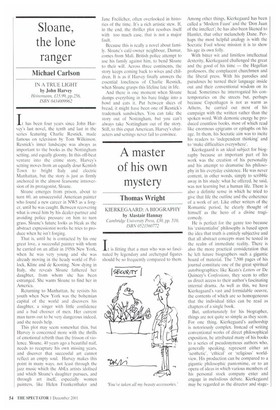Sloane, the lone ranger
Michael Carlson
IN A TRUE LIGHT by John Harvey Heinemann, £15.99, pp256, ISBN 0434009962 It has been four years since John Harvey's last novel, the tenth and last in the series featuring Charlie Rcsnick, made famous on television by Tom Wilkinson. Resnick's inner landscape was always as important to the books as the Nottingham setting, and equally gloomy. In this off-beat venture into the crime story, Harvey's setting moves from an equally dour Kentish Town to bright Italy and electric Manhattan, but the story is just as firmly anchored in the almost fearsome introversion of its protagonist, Sloane.
Sloane emerges from prison, about to turn 60. an unsuccessful American painter who found a new career in NW5 as a forger, until he was caught. Between recovering what is owed him by his dealer-partner and avoiding police pressure on him to turn grass, Sloane's future looks as bleak as the abstract expressionist works he tries to produce when he isn't forging.
That is, until he is contacted by his one great love, a successful painter with whom he carried on an affair in 1950s New York, when he was very young and she was already moving in the heady world of Pollock, Kline and de Kooning. Now dying in Italy, she reveals Sloane fathered her daughter, from whom she has been estranged. She wants Sloane to find her in America.
Returning to Manhattan, he revisits his youth when New York was the bohemian capital of the world and discovers his daughter, a singer with little confidence and a had chooser of men. Her current man turns out to be very dangerous indeed, and she needs help.
This plot may seem somewhat thin, but Harvey is concerned more with the thrills of emotional rebirth than the frisson of violence. Sloane, 40 years ago a beautiful naif, needs to recapture his own missing years, and discover that successful art cannot reflect an empty soul. Harvey makes this point in many ways, not least through the jazz music which the AbEx artists idolised and which Sloane's daughter pursues, and through art itself, especially women painters, like Helen Frankenthaler and
Jane Freilicher, often overlooked in histories of the time. It's a rich artistic stew. If, in the end, the thriller plot resolves itself with too much ease, that is not a major fault.
Because this is really a novel about family. Sloane's café-owner neighbour, Dumar, comes from Mali. British police attempt to use his family against him, to bend Sloane to their will. Across three continents, the story keeps coming back to wives and children. It is as if Harvey finally answers the essential loneliness of Charlie Resnick, when Sloane grasps this lifeline late in life.
And there is one moment when Sloane dumps everything in his bare fridge into a bowl and eats it. Put between slices of bread, it might have been one of Resnick's trademark sandwiches. You can take the story out of Nottingham, but you can't always take Nottingham out of the story. Still, to this expat American, Harvey's characters and settings never fail to convince.




















































































 Previous page
Previous page